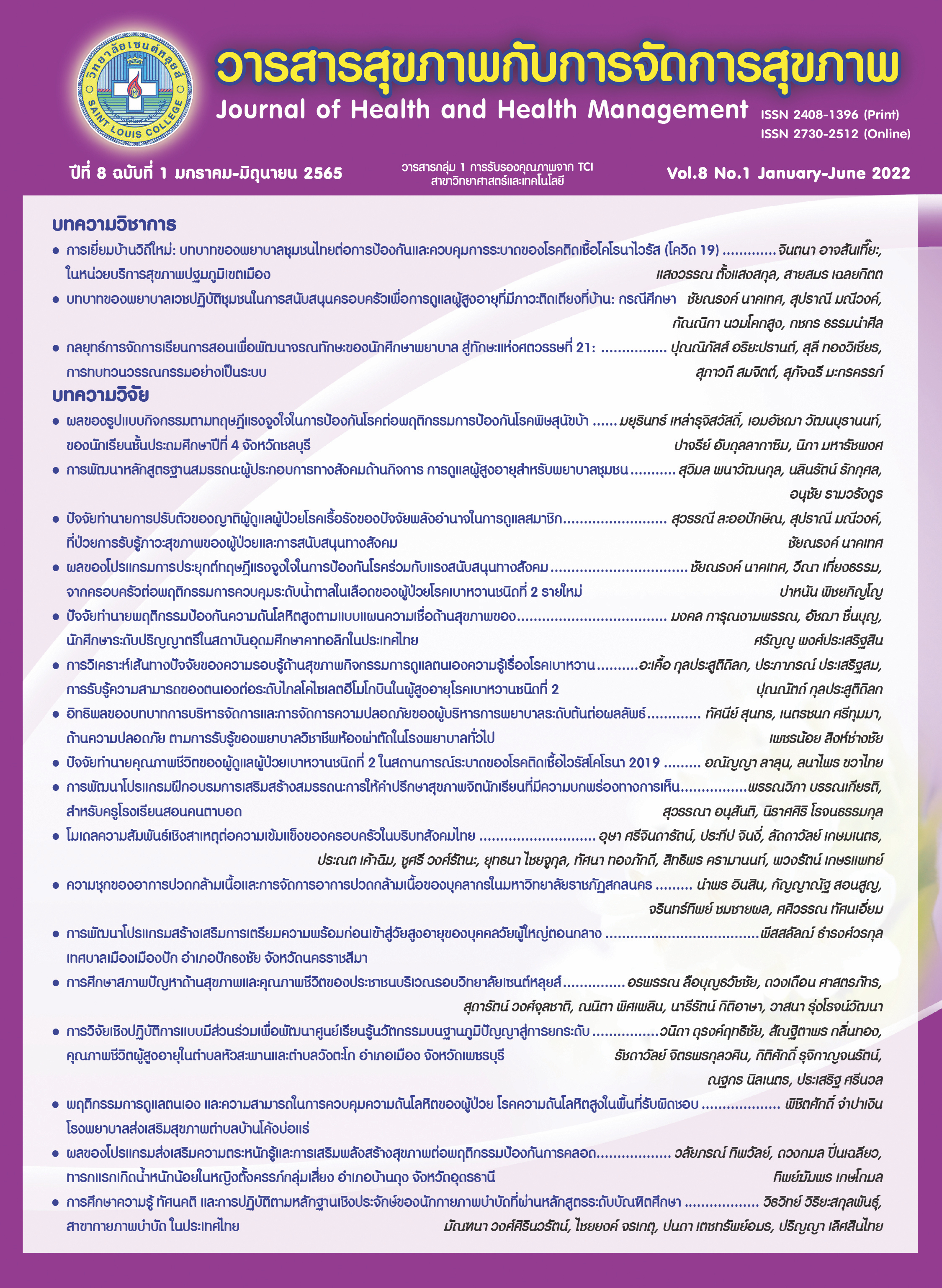Influencing of the Managerial Roles and Safety Management of Frist-line Nurse Managers on Safety Outcomes as Perceived by Professional Nurses of Operating Room in General Hospitals
Keywords:
Managerial roles, Safety management, Safety outcomes, Frist-line Nurse Managers, Operating rooms general hospitalsAbstract
This analytical research was conducted with the objective of testing path model consistency in terms of correlations between managerial roles and safety management with regard to safety outcomes among first-line nurse managers perceived by professional operating room nurses in general hospitals and evidence-based data. The sample was 326 professional operating room nurses in general hospitals (Level S) and was calculated by using Crecy and Morgan’s formula. Research instrument quality was tested by seven qualified experts, and the questionnaires on managerial roles, safety management and safety outcomes yielded content validity indices of 0.90–0.98 with reliability from Cronbach’s Alpha Coefficients of 0.96-0.98. Data were analyzed by using descriptive statistics and path analysis of correlations between variables.
According to the findings, mean scores for the variables of managerial roles, safety management and safety outcomes were found to be high ( = 4.03, 3.86 and 4.45, respectively). The path model of correlations between managerial roles, safety management and safety outcomes was consistent with evidence based data (Chi-square = .007, df = 1, P-value = .934, chi-square/df = .007, CFI = 1.000, GFI = 1.000, AGFI = 1.000, RFI = 1.000, NFI = 1.000, TLI = 1.008, RMSEA = .000, RMR = .000). Managerial roles and safety management were able to jointly explain fluctuations of safety outcome at 20 percent (R2 = .20). With regard to recommendations from the study, managers of nursing organizations and general hospitals can use this path model of correlations to plan and drive concrete policies on safety for patients who will be operated on by developing managerial roles and safety management among first-line nurse managers of the operating room in order to create positive safety outcomes for patients who had surgery.
References
จริญญา บุญรอดรักษ์, อารีรัตย์ ขำอยู่, และโสรัตน์ วงศ์สุทธิธรรม. (2562). ปัจจัยทำนายความสามารถด้านความปลอดภัยผู้ป่วยของพยาบาลวิชาชีพโรงพยาบาลชุมชน จงหวัดชลบุรี. วารสารแพทย์นาวี, 46 (3), 552-565.
สมรัตน์ จารุลักษณานันท์, ยอดยิ่ง ปัญจสวัสดิ์วงศ์, ศิริพร ปิติมานะอารี, เทวรารักษ์ วีระวัฒภนนท์, วรินี เล็กประเสริฐ, ศศิกานต์ นิมานรัชต์, และวราวุธ ภาพพิเศษพันธุ์. (2560). การศึกษาอัตราการเสียชีวิต และภาวะแทรกซ้อนทางวิสัญญีจากการรายงานอุบัติการณ์ในประเทศไทย. กรุงเทพฯ:รายงานการวิจัยสถาบันวิจัยระบบสาธารณสุข.
Ammouri, A. A. Tailakh, A. K. Mullira, J. K., & Greethakrishnan, R. (2015). Patient safety culture among nurses. International Nursing Review, 62(1), 102-110. https://doi.org/10.1111/inr.12159
Au Yong, H. N., Usmonov, K., Ramendran, S. P. R., C., & Yeoh, G. G., & Surienty, L. (2018). Pilot testing on safety performance among healthcare professionals. Journal of Generic Medicines: The Business Journal for the Generic Medicines Sector, 14(3), DOI:10.1177/1741134318776702 https://doi.org/10.1177/1741134318776702
Brislin, R. W. (1986). The wording and translation of research instruments. in W. L. Lonner & J. W. Berry (Eds). Field Methods in Cross-cultural Research, Newbury Park, CA, 185-216.
DeVellis, R. F. (2012). Scale development: Theory and application. Newbury Park, CA: Sage.
Donabedian, A. (2003). An Introduction to Quality Assurance in Health Care. Oxford: Oxford University Press.
Fernández-Muñiz, B., Montes-Peon, J. M., & Vazquez-Ordas, C. J. (2007). Safety management system: Development and validation of a multidimensional scale. Journal of Loss Prevention in the process Industries, 20(1), 52-68. https://doi.org/10.1016/j.jlp.2006.10.002
Gubta, K. K., Attri, J. P., Singh, A., Karu, H., & Karu, G. (2016). Basic concepts for sample size calculation: Critical step for any clinical trials. Saudi J Anaesth, 10(3), 328-331. https://doi.org/10.4103/1658-354X.174918
Hair, J. F., Black, W. C., Babin, B. J., Anderson, R. E., & ham Ronald, L. (2010). Multivariate Data analysis (7thed.). New Jersy: Prentice. Philadelphia.
Krejcie, R. V., & Morgan, D. W. (1970). Determining sample size for research activities. Educational and psychological measurement, 30(3), 607-610. https://doi.org/10.1177/001316447003000308
Martins, F. Z., & Dall'Agnol, C. M. (2016). Surgical center: challenges and strategies for nurses in managerial activities. Original Papers Rev. Gaúcha Enferm. (Online), 37(4), e56945 https://oi.org/10.1590/1983-1447.2016.04.56945
NHS Improvement. (2017). Provisional publication of never events reported as occurring between 1 April 2017 and 31 January 2018. Retrieved from: https://improvement.nhs.Uk/resources/.never-events-data/
Parker, J. (2015). Root cause analysis in healthcare: tools and techniques (5thed.). Department of Publications and Education. Joint Commission Resources. Illinois: Oak Brook.
Parreira, P., Lopes, A., Salgueiro, M. F., Carvalho, C., Salgueiro-Oliveira, A., Castilho, A., & Fonseca, C. (2015). Quinn's Leadership Roles: A Confirmatory Factor Analysis Study in Portuguese Health Services. César João Fonseca, 11(1), 177-202. https://doi.org/10.24902/r.riase.2015.1(2).192
Polit, D. F., & Beck, C. T. (2017). Research in NursingGenerating and Assessing Evidence for Nursing Practice (10thed.). Philadelphia: Lippincott Williams & Wilkins.
Quinn, R. E., Faerman, S. R., Thompson, M. P., & McGrath, M. R. (2003). Becoming a Master Manager: A Competency Approach (3rded.). Hoboken. NJ: John Wiley & Sons.
Spigener, J. (2017). Safety Leadership: 1 1 characteristics of great safety performers. Safety + Health. The official magazine of the NSC Congress & Expo. Retrieved from https://www.safetyandhealthmagazine.com/articles/15960-safety-leadership -[2018, October 15]
Uribe-leitz, T., Jaramilo, J., Maurer, L., Fu, R., Esquivel, M. M., Gawande, A. A., et al. (2016). Variability in mortality following caesarean delivery, appendectomy, and groin hernia repair in low-income and middle-income countries: a systematic review and analysis of published data. Lancet Glob Health, 4(3), e165-74. https://doi.org/10.1016/S2214-109X(15)00320-4
World Health Organization (WHO). (2016). Atlas of eHealth country profiles: the use of eHealth in support of universal health coverage. Retrieved from https://www.who.int/publications/i/item/9789241565219 [accessed 2021-04-29]
Zabihirad, J., Mojdeh, S., & Shahriari, M. (2019). Nurse's perioperative care errors and related factors in the operating room. Electron J Gen Med, 16(2), 1-6. https://doi.org/10.29333/ejgm/94220
Downloads
Published
How to Cite
Issue
Section
License
Copyright (c) 2022 Journal of health and health management

This work is licensed under a Creative Commons Attribution-NonCommercial-NoDerivatives 4.0 International License.




